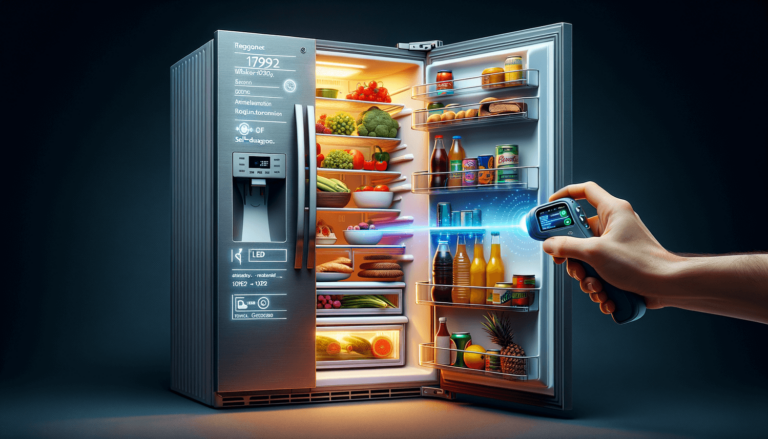

Discover the inner workings of your Whirlpool refrigerator with our comprehensive guide on diagnostics. In this blog post, we will demystify the processes involved in troubleshooting common issues, while providing valuable insights into the various error codes and their meanings. Follow along to learn how to efficiently and accurately diagnose your appliance, ensuring optimal performance for years to come.
1. Unplug the refrigerator: Disconnect your Whirlpool refrigerator from the power source to ensure safety before you run any diagnostics.
2. Locate the tech sheet: Find the tech sheet behind the refrigerator’s front grille, within the user manual, or printed on the back of the appliance. This sheet contains crucial diagnostic information, including error codes and testing procedures.
3. Enter diagnostic mode: Most Whirlpool refrigerators have a diagnostic mode that you can activate by pressing a specific sequence of buttons on the control panel. Consult the tech sheet for the appropriate procedure for your model.
4. Run diagnostic tests: Once in diagnostic mode, go through the series of tests outlined in the tech sheet. These tests assess various components, such as the thermostat, defrost heater, and evaporator fan.
5. Check error codes: If any issues are detected, the refrigerator will display an error code. Note these codes and consult the tech sheet to understand their meaning and the corresponding corrective action.
6. Address the issue: Based on the error code and its meaning, fix or replace the faulty component as recommended in the tech sheet.
7. Exit diagnostic mode: After addressing the issue, exit the diagnostic mode following the procedure outlined in the tech sheet.
8. Plug the refrigerator back in: Reconnect your Whirlpool refrigerator to the power source and observe its operation. If the issue persists, repeat the diagnostic process or consult a professional technician for assistance.
Whirlpool refrigerators are equipped with diagnostic systems that help identify any operational issues. This guide will provide you with an in-depth look into the diagnostic process, enabling you to solve common problems for maintaining optimal appliance performance.
The tech sheet serves as a comprehensive guide containing essential information for diagnostics. It provides instructions on entering diagnostic mode, performing tests, and interpreting error codes. You can typically find the tech sheet in the following locations:
Entering diagnostic mode in your Whirlpool refrigerator requires a specific button sequence. The sequence may vary based on your model, so refer to the tech sheet for the correct procedure. Here is a general outline of the process:
Once in diagnostic mode, follow these steps to run tests on your Whirlpool refrigerator:
Error codes serve as valuable tools for identifying issues within your refrigerator. The tech sheet will provide a comprehensive list of error codes, as well as their meanings and recommended solutions. Some common error codes include:
Consult the tech sheet for guidance on addressing these issues, and replace or repair any faulty components as needed.
After completing tests and addressing any issues, follow these steps to exit diagnostic mode:
If the problem persists or you encounter any challenges during the diagnostic process, consult a professional technician for assistance.
Understanding your Whirlpool refrigerator’s diagnostic process equips you with vital information to address potential issues. Swift identification and repair not only save time and money but also prolong your appliance’s lifespan. Familiarity with diagnostics can help prevent frustrating situations, such as spoiled food due to unforeseen refrigerator malfunctions.
At Settings King, your go-to blog for technology settings, we believe that being well-versed in the Whirlpool refrigerator diagnostic process can elevate your appliance maintenance game. Our aim is to provide comprehensive guides and support to ensure you get the most out of your appliances. While our guidance can help you identify and address most issues, keep in mind that certain situations may require expert technicians. Consult a professional if you are ever unsure about any step in the process.
Beyond diagnostics, regular maintenance plays a crucial role in ensuring that your Whirlpool refrigerator operates efficiently. Here are some practical tips to keep your appliance running smoothly:
While Settings King strives to support you with expert diagnostic guidance, take advantage of Whirlpool’s after-sales support for any model-specific queries or assistance. A good after-sales support system not only provides added peace of mind but also ensures that your appliance remains in top condition.
We understand that you may have some questions and concerns related to the Whirlpool refrigerator diagnostic process. To help address these inquiries, we’ve compiled a list of frequently asked questions and provided concise NLP-style answers.
If you are unable to locate the tech sheet, you can contact Whirlpool’s customer support or visit their website. They may provide you with a digital copy of the tech sheet for your specific model.
It is strongly advised to unplug your refrigerator before entering diagnostic mode. This precaution ensures your safety and prevents potential damage to the appliance due to electrical issues.
While diagnostic procedures share some similarities across Whirlpool refrigerator models, there may be variations depending on the specific model. Always refer to your appliance’s tech sheet for accurate diagnostic information and procedures.
Incorrectly addressing an issue based on misinterpreting error codes can potentially cause additional damage. If unsure, consult with a professional technician to assess, diagnose, and repair your refrigerator correctly. Never attempt repairs you are not confident about.
Running diagnostics when you first notice a problem is recommended. There is no need for regular diagnostics; however, it can be helpful to become familiar with the signs of common issues and address them proactively to ensure optimal functionality.